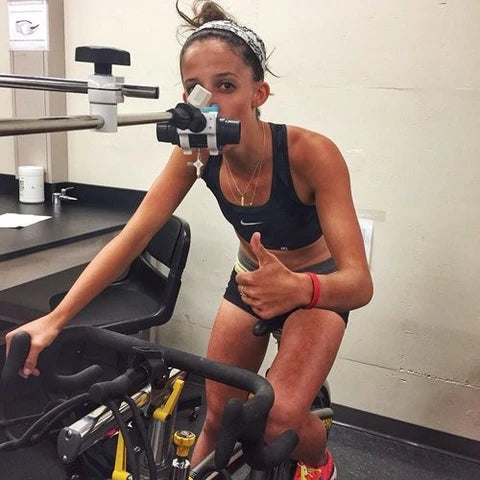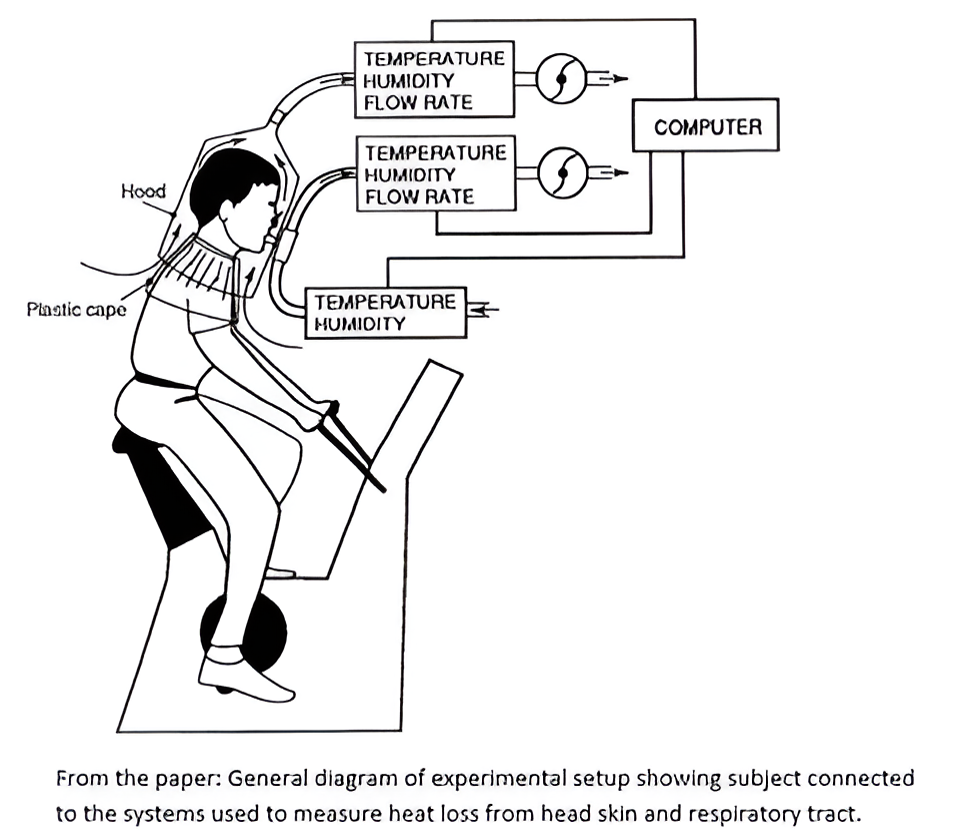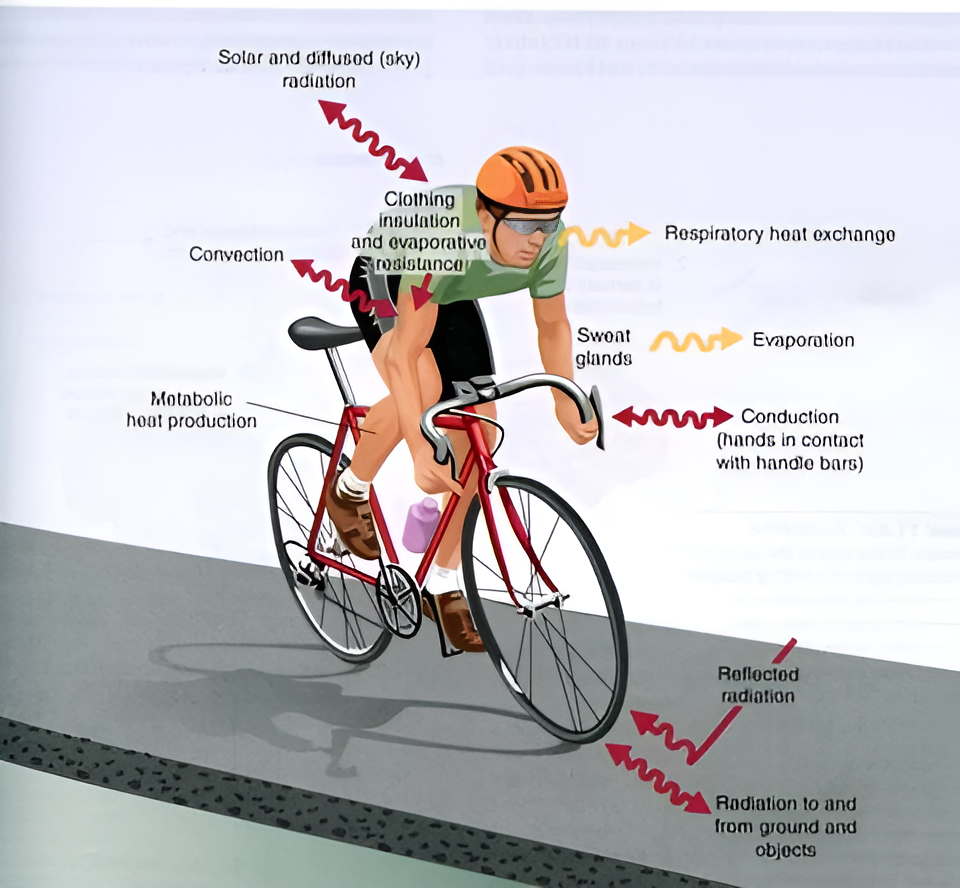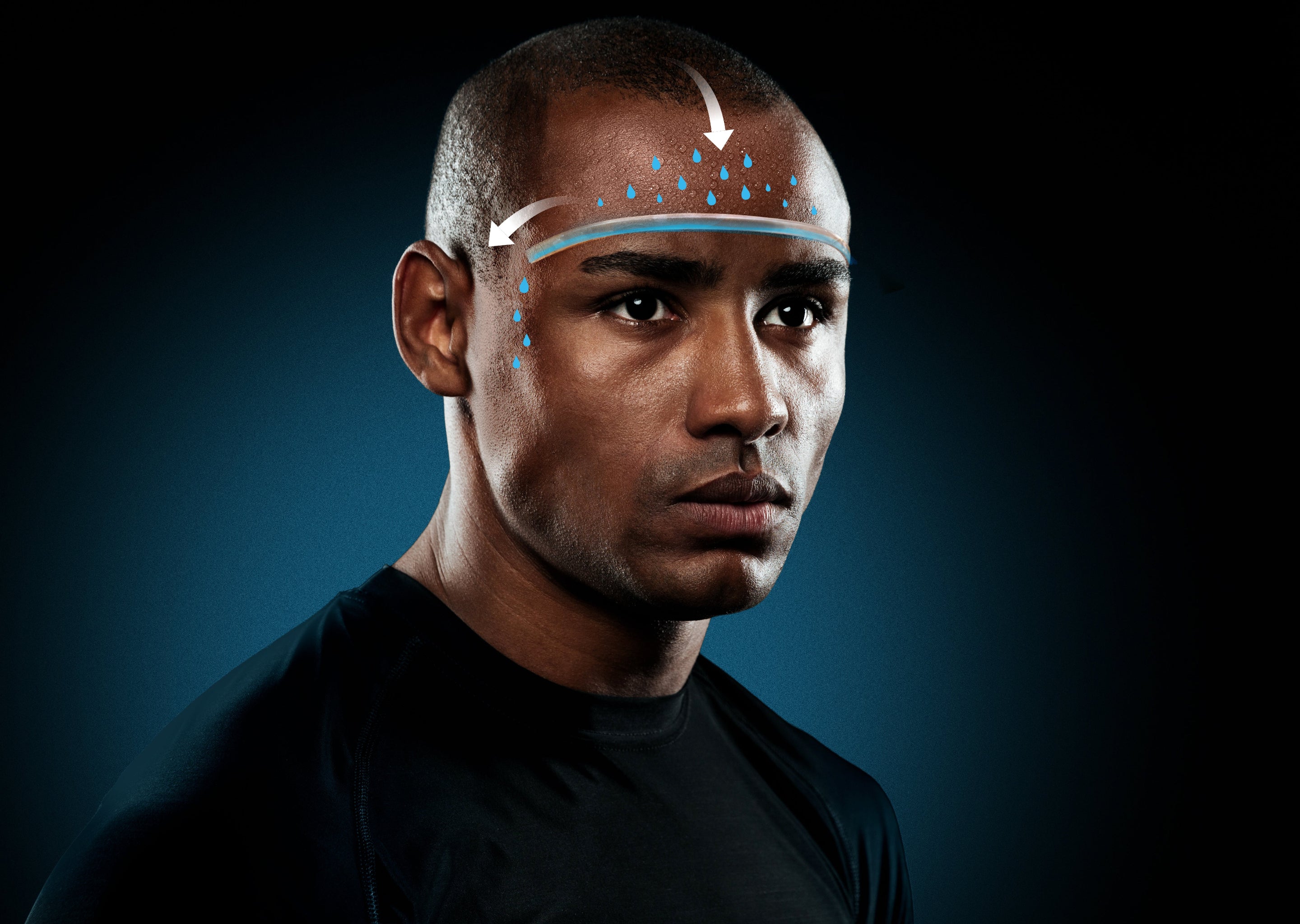The Science Behind Veo
Veo allows sweat to do its cooling job but prevents its drawbacks.
Sweat cools by evaporation from the skin’s surface, the forehead is the best skin on the body for this purpose.
Veo covers minimal skin, maximizing airflow and cooling at the forehead.
Cooler forehead means less sensation of fatigue.
Scientific Research Underpins Veo Design Rationale
Below we highlight the relevant published scientific research, followed by the references themselves.
During Exertion, The Forehead Produces More Sweat Per Square Inch And More Sweat Increase Than Any Other Part of the Body
The study recorded sweat rates in 41 regions of the body, including six on the head. Study participants exercised at 55% and 75% of their maximum exercise intensity in a controlled environment at 78°F. The standard measure of exercise intensity, percentage of maximal oxygen uptake (VO2 max), was used. This is a scientifically-accepted means of equating different individuals’ exertion level. The authors calculated sweat rates in the separate regions at each of the two intensity levels using absorbent pads and rigorous methods of collecting sweat from only the selected regions. They compared both the absolute and relative changes in sweat rates in the each area.
The forehead produced the largest absolute volume of sweat per unit of area. The athletes’ foreheads sweated 2.6x the average overall sweat rate for all the measured areas, and 43% more than the next highest area. Sweat production at 75% of VO2 max averaged 12cc and ranged as high as over 18cc per hour. Recalling that 75% ofVO2max is still below a long Thermal Physiology PhD Caroline J. Smith and Medical Physiology PhD George Havenith of Loughborough University studied variations of sweat rates in each region of the body in elite and sub-elite athletes.The authors had a particular interest in sportswear and skin coverage and its implications for heat transfer: “Sweat production in different body regions is relevant for the analysis of the body’s heat exchange since clothing cover varies over different body parts, in addition to regional heat transfer coefficient differences resulting from air and body movement."
Distance sustainable exercise rate, it is not possible absorb all sweat that can be produced at the forehead. The problem is exacerbated when production from the scalp, draining via the forehead, is added and exercise intensity is increased beyond 75%.

Bloodflow to the Forehead Increases by 12x During Exercise, Specifically to Aid Cooling
Japanese researchers Kohei Sato PhD et. al. at the Toyko University and the Research Institute of Physical Fitness, Japan Women’s College of Physical Education, Tokyo, studied changes to blood flow to the during cycling exercise. They looked at blood flow to the head as exercise intensity increased, also measured by percentage of VO2 max. They found that blood flow to the forehead grew by over 12x as percent of VO2 max increased from 40% to 80%.
They conclude, in part, that the blood flow to the face is selectively increased for thermoregulatory (cooling) purposes, and that there is a positive relationship between forehead skin blood flow from moderate to heavy exercise, potentially reflecting a direction of blood flow to the skin to aid heat dissipation. They point out that the skin blood flow increase at the forehead during exercise is significantly greater than skin blood flow at the chest, forearm, thigh and back, and suggest that this reflects the high priority the body places on cooling at the head.

Heat Exchange With The External Environment Via The Head Is Central
One of the head’s key functions is to blow off heat. In this Rasch, et. al. (Department of Physiology, Laval University Quebec Canada) study, the authors focused on the head’s ability to dissipate heat to the environment for the purpose of protecting the brain. They devised an elaborate test fixture that isolated the head’s thermal dissipation capacity from the rest of the body and measured what happened during exercise-generated heating (“hyperthermia”). They found that the head can eliminate heat faster than the body can “supply” it to the brain. At 25°C, the head’s skin can lose 132 +/- 32 watts. This exceeds the 45 watts brought to the head by arterial blood flow per each 1°C of temperature above normal, plus 20 watts generated by the brain. They conclude that “The human head, from a strictly physical point of view, can function as a heat sink with a heat loss capacity higher than the heat produced by the brain and received from the arterial blood during hyperthermia.” Thus, one should impede this important process as little as possible with head coverings.
Covering the Forehead Traps Heat and Rapidly Increases Athlete Temperature
Though the purpose of the study was not to determine relative skin temperatures, the authors did collect data on the increase in skin temperature during the periods when absorbent pads were applied (the final 5 minutes of a 30 minute session at the target exercise level) to measure sweat volume. Core temperature increased to only 100.7°F during exercise, but after only 5 minutes of forehead coverage, temperature there increased by an average of 3°F.
The study shows that the forehead is prime sweat producing territory, and that covering that territory causes big temperature increases. This is of critical importance, as shown in the next paragraph.
Cooling At The Forehead Creates Multiple Physiological Benefits
These two references detail the tremendous benefits of cooling at the forehead during exercise. While the methods used in these two studies are cited by the authors as "impractical" for active users, the directional indication is clear. To the extent possible, nothing should be used that traps or increases heat at the forehead. (Because Veo covers minimal skin surface, and allows sweat unimpeded access to evaporate from the surface of the skin, it promotes cooling at the forehead.) The enumerated benefits from the two studies include lower heart rate and less lactic acid buildup in the blood, meaning better oxygen perfusion of the muscles. They also reported lower core body temperature, and one of the most important findings was a reduction in perceived level of exertion for the same level of aerobic intensity.

The Forehead is Particularly Important to Cooling and Can Dissipate Heat at 4x the Rate of the Torso
Authors Taylor et.al. at the University of Wollongong, Australia reported on their research into rates of heat dissipation potential from the hands and feet, published at the International Conference on Environmental Ergonomics. Though their work did not focus on the forehead, they do state that “Indeed, when normalized to surface area, the potential evaporative heat loss from the two hands is 110% greater than at the torso, and 200% greater than at the two feet, but only half that at the forehead.” That is, the forehead can dissipate 4x as much heat as the torso per unit of surface area.
Traditional Coverage Headbands Increase Surface Temperature, Operating Against All The Benefits Described Above
One notion that permeates all the reference papers is the importance of Selective Brain Cooling (“SBC”). These authors performed heat loss measurements in subjects with and without headbands. Perhaps it is somewhat obvious that headbands increase heat and retard heat loss, but this study confirms it. They tested core and surface temperatures in athletes undergoing exercise with and without headbands, and learned that the headband does indeed impede heat loss and SBC. This corroborates the reported findings in the section above relating to skin temperature increase after occlusion, and in a more direct manner.
THESE STUDIES AND OTHERS DIRECTLY SUPPORT DIVERTING SWEAT RATHER THAN IMAGINING IT IS POSSIBLE TO CAPTURE IT ALL, AND COVERING MINIMAL SKIN TO DO IT.
REFERENCES:
1. Smith, CJ and Havenith, G - Body mapping of sweating patterns in male athletes in mild exercise-induced hyperthermia. Eur J Appl Physiol 111: 1391–1404 (2011).
2. Kohei Sato, Shigehiko Ogoh, Ai Hirasawa, Anna Oue and Tomoko Sadamoto (2011) - The distribution of blood flow in the carotid and vertebral arteries during dynamic exercise in humans; J Physiol 589.11 2847–2856.
3. Rasch, P. Samson, J. Cote, and M. Cabanac. Heat loss from the human head during exercise. J Appl Physiol (1985). 1991 Aug;71(2):590-5.
4. Ruddock, A, Robbins, B, Tew, G, Bourke, L, Purvis, A - Practical cooling strategies during continuous exercise in hot environments: A systematic review and meta-analysis. Sports Med (2017) 47:517-532.
5. Mündel, T, Bunn, SJ, Hooper, PL, Jones, DA - The effects of face cooling during hyperthermic exercise in man: evidence for an integrated thermal, neuroendocrine and behavioral response. Exp Physiol 2007 Jan;92(1):187-95)
6. Taylor, N. A.S.., Machado-Moreira, C., van den Heuvel, A., Caldwell, J., Taylor, E. A.. & Tipton, M. J.. The roles of hands and feet in temperature regulation in hot and cold environments. Thirteenth International Conference on Environmental Ergonomics; Boston, USA: University of Wollongong; 2009. 405-409.
7. Rasch, W, Cabanac, M - Selective brain cooling is affected by wearing headgear during exercise. J Appl Physiol (1985) 1993 Mar;74(3):1229-33.


